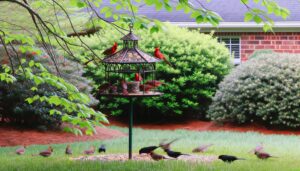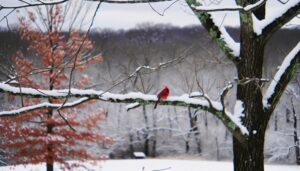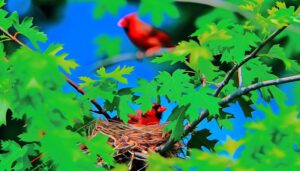Do Cardinals Migrate for Winter?
You might be surprised to know that cardinals don't migrate for the winter. These resilient birds remain in their habitats, relying on dense shrubbery, evergreen trees, and bird feeders for food and shelter.
Cardinals adapt to cold climates by foraging for seeds, berries, and insects. Their territorial aggression and bright plumage, especially in males, play an essential role in defending resources.
They exhibit fascinating regional adaptations and display resilience to climate change impacts. If you're interested in the intricacies of their winter behaviors and habitat preferences, there's a wealth of detailed observations to explore.
Key Takeaways
- Cardinals generally do not migrate and stay in their habitat year-round.
- They exhibit altitudinal migration, moving to lower elevations for better food and climate during winter.
- Their survival relies on dense shrubbery, mixed forests, and evergreens for shelter and food access.
- Cardinals adapt their foraging strategies to utilize available seeds, fruits, insects, and bird feeders.
- Climate change impacts cardinal behavior, forcing adaptations in habitat use and food sourcing.
Cardinal Migration Overview
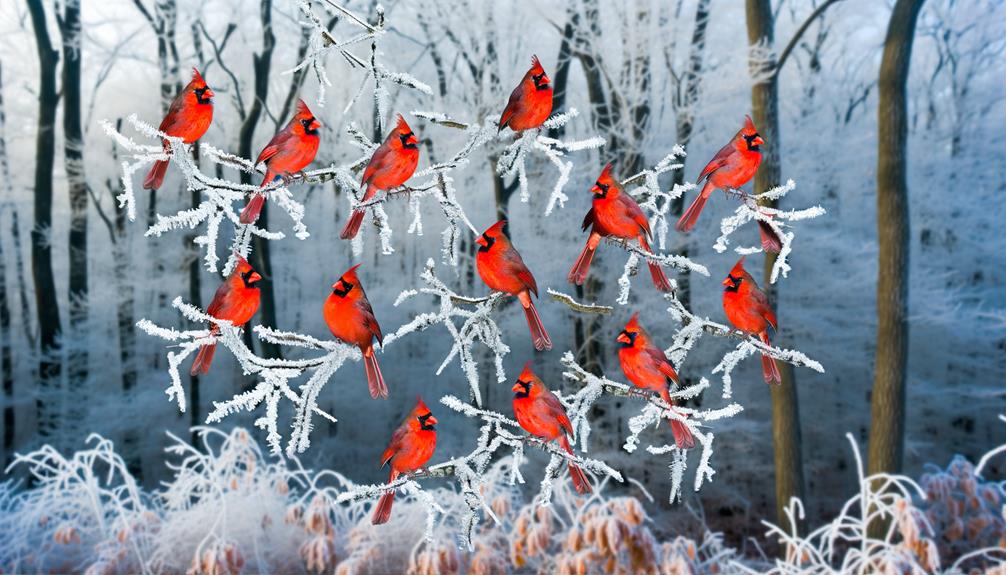
Cardinal migration, primarily driven by seasonal changes, involves precise patterns and behaviors critical for their survival. You'll observe that these birds exhibit remarkable navigational skills, using environmental cues like the Earth's magnetic field and the position of the sun.
They don't travel great distances like some other species but may shift to different elevations or locales within their range. This movement, known as altitudinal migration, guarantees they access abundant food sources and suitable climates. Monitoring their migratory routes reveals how cardinals adapt to fluctuating resources.
You'll find that understanding these patterns is essential for conservation efforts, confirming that the habitats they rely on are preserved. Their migration is a reflection of their resilience and adaptability in the face of seasonal challenges.
Cardinal Winter Habitat
You'll find that cardinals prefer winter habitats in regions with dense shrubbery and forested areas, where they can seek shelter and establish nesting sites.
They rely heavily on the availability of food sources like seeds, berries, and insects to survive the colder months.
Understanding these preferences can help you secure their conservation and study their migratory patterns with greater precision.
Preferred Winter Regions
During the winter months, Northern Cardinals exhibit a preference for habitats that provide ample food sources and dense cover, such as wooded areas and suburban gardens. You'll often find them in regions that offer:
- Mixed deciduous forests: These areas provide a variety of seeds and berries.
- Shrubby undergrowth: Dense shrubs offer protection from predators and harsh weather.
- Evergreen trees: Conifers offer year-round foliage and shelter.
- Bird feeders: Suburban gardens often feature feeders stocked with sunflower seeds and suet.
Cardinals thrive in these environments due to the availability of food and protection. Their vibrant red plumage contrasts beautifully against snow-covered landscapes, making them a striking presence in winter habitats. Understanding their preferred regions helps in appreciating their adaptability and resilience during colder months.
Shelter and Nesting Sites
In winter habitats, Northern Cardinals often seek shelter in dense thickets, evergreen groves, and well-concealed areas that offer both protection and ideal microclimate conditions for survival. You'll find that these birds prefer areas where they can evade predators and minimize exposure to harsh weather. Their nesting sites are carefully chosen to balance concealment and accessibility.
Here's a table summarizing key shelter characteristics:
| Shelter Type | Protection Level | Microclimate Conditions |
|---|---|---|
| Dense Thickets | High | Moderate |
| Evergreen Groves | Medium | High |
| Concealed Areas | High | Variable |
These habitats are essential for their thermal regulation and safety. By understanding their preferences, you can better appreciate how these resilient birds navigate winter challenges.
Food Sources Availability
While Northern Cardinals find shelter in dense thickets and evergreen groves, their winter survival also hinges on the availability of reliable food sources. You'll notice these vibrant birds frequenting areas where food is abundant. They rely heavily on:
- Seeds: Sunflower seeds and millet are staples.
- Fruits: Berries from dogwood, sumac, and wild grapes.
- Insects: During mild winter spells, they may hunt for beetles and caterpillars.
- Feeders: Backyard bird feeders stocked with black-oil sunflower seeds.
Cardinals possess robust bills designed for cracking seeds, and their adaptability in foraging ensures they make the most of diverse food sources.
Securing these food sources are available in winter habitats can help maintain cardinal populations without the need for migration.
Historical Migration Patterns

Cardinals have historically exhibited consistent seasonal migration patterns, with populations primarily shifting southward in response to colder temperatures and food scarcity. You'll notice these movements align with decreasing daylight and the subsequent decline in insect activity, which forms a significant part of their diet.
During winter, cardinals used to travel from northern latitudes to more temperate southern regions, ensuring better access to sustenance. Ornithologists have meticulously documented these patterns, utilizing banding and tracking techniques to monitor their routes. Migratory behavior also varies based on geographic location, with northern populations exhibiting more pronounced migrations compared to their southern counterparts.
This historical trend underscores the cardinals' adaptability and resilience in fluctuating environmental conditions, ensuring their survival through centuries of climatic changes.
Reasons for Staying Put
You've likely noticed that recent winters see more cardinals opting to remain in northern regions, a phenomenon driven by several interconnected factors. This shift can be attributed to changes in climate, habitat conditions, and human influence.
Cardinals have adapted remarkably well to suburban environments, where they find shelter and consistent conditions. Additionally, physiological adaptations allow them to withstand colder temperatures better than many other birds.
Consider these factors:
- Urban heat islands: Cities tend to be warmer due to human activity.
- Dense vegetation: Provides natural insulation against the cold.
- Stable microclimates: Suburban areas offer a steady environment.
- Reduced predation: Urban settings often have fewer natural predators.
These elements collectively encourage cardinals to stay put, reflecting their resilience and adaptability.
Food Sources in Winter
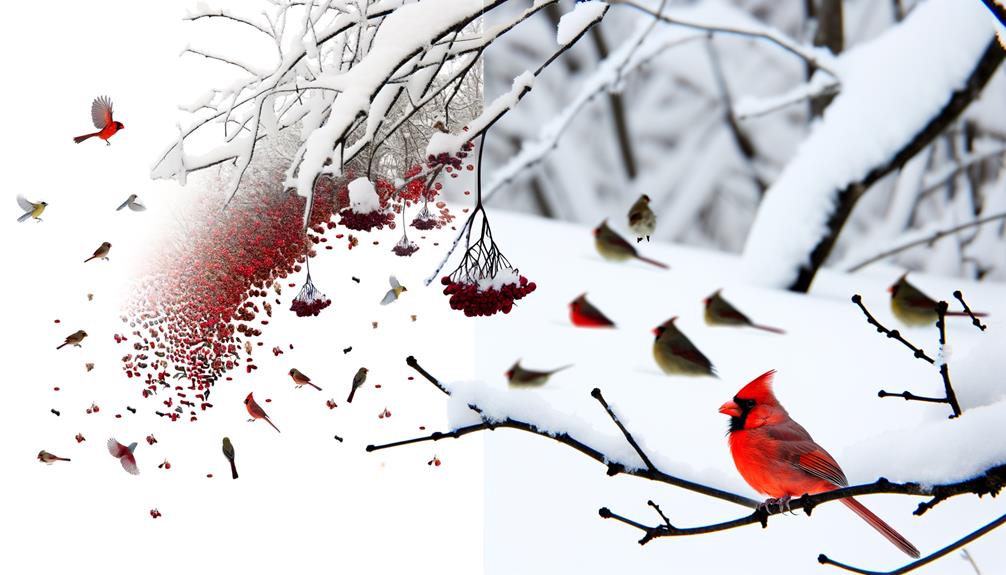
As winter sets in, the availability of reliable food sources becomes a key factor influencing cardinals' decision to remain in northern regions.
You'll observe that cardinals rely heavily on seeds, fruits, and insects. During winter, seeds from plants like sunflowers, grasses, and weeds are critical.
You can also find them frequenting bird feeders stocked with sunflower seeds, safflower seeds, and cracked corn. These food sources provide essential calories and nutrients, enabling them to maintain their energy levels.
Cardinals are also known to forage for berries from shrubs and trees such as dogwood, sumac, and viburnum. The presence of these food sources can significantly determine whether cardinals will stay put through the harsh winter months or seek sustenance elsewhere.
Adapting to Cold Weather
When observing cardinals during winter, you'll notice their remarkable winter survival strategies, including changes in behavior and physiology.
Pay attention to how they optimize food sources availability by foraging in groups and utilizing bird feeders.
Additionally, their choice of shelter and protection, such as dense shrubs and evergreen trees, is vital for maintaining body heat and avoiding predators.
Winter Survival Strategies
Cardinals employ several winter survival strategies. They increase their metabolic rate and utilize communal roosting to maintain body heat in frigid temperatures. You'll notice these vibrant birds adapting to the cold with remarkable tactics.
They puff up their feathers to trap insulating air, creating a thermal barrier against the cold. Additionally, cardinals seek out dense foliage for shelter.
- Feather fluffing: Creates an insulating layer of air.
- Communal roosting: Groups of cardinals huddle together for warmth.
- Dense foliage sheltering: Offers protection from wind and snow.
- Metabolic rate increase: Generates extra body heat.
Food Sources Availability
In cold weather, the availability of food sources for cardinals becomes a critical factor, requiring their adaptation through diverse foraging strategies and dietary adjustments.
You'll notice that cardinals broaden their diet to include more seeds, berries, and even insects when available. They frequently visit bird feeders, making use of sunflower seeds and other high-calorie offerings to maintain their energy levels.
Additionally, cardinals demonstrate a behavior called 'scatter hoarding,' where they store food in different locations to guarantee consistent access.
Shelter and Protection
How do these vibrant birds guarantee their survival through the frigid months? Cardinals adapt by seeking shelter and protection in dense foliage and evergreen trees. These natural insulators help retain body warmth.
You'll often find cardinals utilizing:
- Thick shrubs: Provide windbreaks and concealment from predators.
- Evergreen trees: Offer year-round cover and thermal insulation.
- Brush piles: Created from fallen branches, these serve as makeshift shelters.
- Nest boxes: Artificial structures can substitute for natural shelters.
Cardinal Behavior in Winter

Ever wondered why Northern Cardinals exhibit such territorial aggression during the winter months? During this season, resources like food and shelter become limited, prompting cardinals to fiercely defend their territories.
You'll notice males displaying bright plumage and engaging in aggressive behaviors such as song battles and physical confrontations to ward off intruders. These actions make sure they maintain access to essential resources.
Female cardinals, though less conspicuous, also partake in defending their nesting sites. This heightened territoriality is vital for their survival, ensuring they secure enough food to endure the cold months.
Differences by Region
Depending on the region, Northern Cardinals exhibit distinct behavioral and physiological adaptations that allow them to thrive in diverse climates and habitats. In northern areas, you'll observe thicker plumage and increased fat reserves to endure colder temperatures. Conversely, cardinals in southern regions display leaner bodies and engage in more frequent foraging due to milder conditions.
These regional adaptations underscore the cardinal's incredible flexibility and resilience, ensuring they flourish across a broad spectrum of environments without the need for migration.
- Dense, shrub-filled environments: provide abundant cover and nesting sites.
- Urban areas: offer reliable food sources, especially from bird feeders.
- Woodlands and forests: supply varied diets and natural shelter.
- Wetlands: present unique foraging opportunities with aquatic insects.
Impact of Climate Change
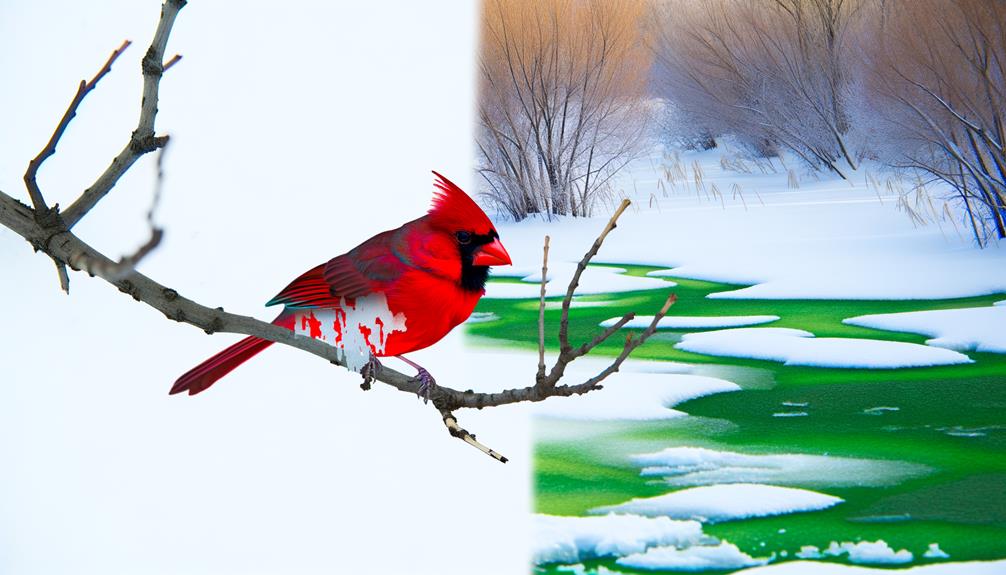
Climate change profoundly affects Northern Cardinals by altering their habitats and food availability, forcing them to adapt or face population declines. You'll notice shifts in their geographical range as rising temperatures push them northward.
Warmer winters can disrupt their breeding cycles, leading to lower reproductive success. Changes in precipitation patterns affect plant phenology, impacting the availability of seeds and insects that cardinals rely on.
Increased frequency of extreme weather events, such as storms and heatwaves, can damage habitats and reduce survival rates. You might observe these changes directly in your backyard, where altered migration patterns and shifting species interactions become evident.
Helping Cardinals in Winter
To support cardinals during winter, you can establish consistent food sources by providing a supply of high-fat seeds and suet. Additionally, create or maintain dense shrubbery and evergreen trees to offer shelter and protection from predators and harsh weather.
Guarantee water availability by using heated bird baths to prevent freezing.
Providing Food Sources
Ensuring cardinals have access to high-energy food sources like sunflower seeds and suet during winter months is vital for their survival. By providing nutrient-dense options, you help them maintain their energy and body heat.
Consider offering the following:
- Black-oil sunflower seeds: Rich in fat and protein, these seeds are a cardinal favorite.
- Peanut hearts: Packed with calories, they provide an essential energy boost.
- Suet cakes: These fat-based blocks are excellent for cold weather, supplying necessary fats.
- Safflower seeds: Less appealing to squirrels, they attract cardinals and provide essential nutrients.
Position feeders in accessible areas, ensuring they're regularly replenished. This practice not only aids cardinals but also invites a vibrant winter birdwatching experience right in your backyard.
Shelter and Protection
Creating suitable shelter is crucial for cardinals to withstand harsh winter conditions and evade predators. You can provide natural cover by planting dense bushes or evergreen trees. These offer insulation from cold winds and hiding spots from predators. Additionally, consider installing roosting boxes, which can safeguard cardinals from inclement weather and provide secure resting places.
| Shelter Type | Benefits |
|---|---|
| Dense Bushes | Insulation, predator evasion |
| Evergreen Trees | Year-round cover, wind protection |
| Roosting Boxes | Weather protection, secure roosts |
Maintaining these shelters guarantees that cardinals have safe havens during winter. Regularly check and clean roosting boxes to prevent disease, and prune bushes minimally to preserve their density. By doing so, you'll help cardinals thrive despite winter's challenges.
Water Availability
Providing a reliable water source is vital for cardinals' survival during winter when natural water supplies may freeze over. You should consider implementing a heated birdbath to prevent water from freezing. This guarantees a consistent supply of liquid water, which is essential for their hydration and metabolic functions.
Here are some practical tips to help cardinals stay hydrated:
- Heated birdbath: Keeps water from freezing, ensuring accessibility.
- Regular refilling: Maintain water levels to avoid contamination.
- Sheltered placement: Position it in an area protected from wind and predators.
- Cleanliness: Regularly clean to prevent algae and bacterial growth.
Observing Cardinals Year-Round
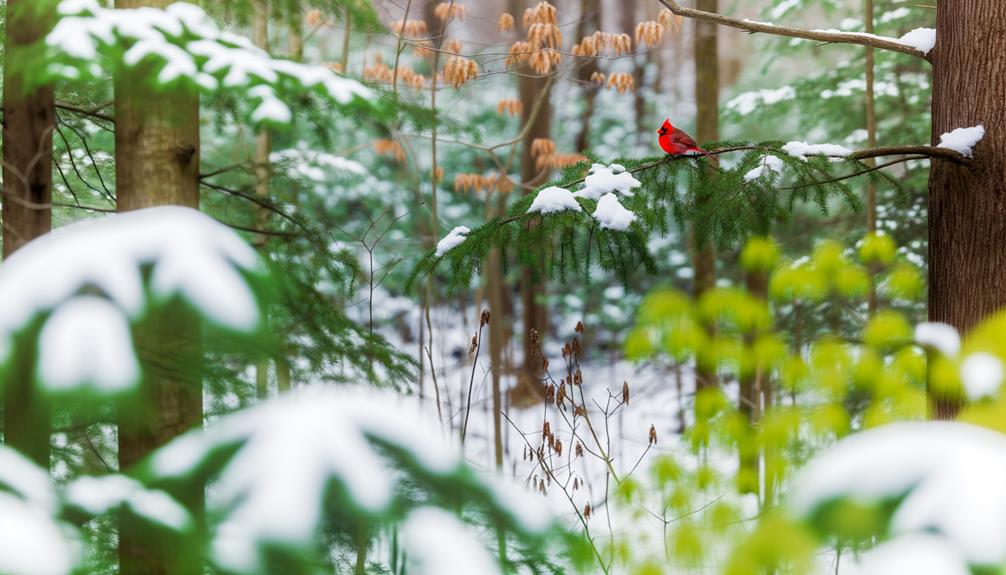
By setting up a variety of feeders and planting native shrubs in your backyard, you can attract and observe cardinals year-round in their natural habitat. Make sure you provide a mix of black oil sunflower seeds, safflower seeds, and cracked corn. Native shrubs like dogwood, sumac, and serviceberry offer essential cover and food.
Here is a quick reference for best cardinal observation:
| Time of Year | Food Type | Shrubs |
|---|---|---|
| Winter | Black oil sunflower seeds | Dogwood |
| Spring | Safflower seeds | Sumac |
| Summer | Cracked corn | Serviceberry |
| Fall | Mixed seeds | Elderberry |
| Year-Round | Suet cakes | Juniper |
Observing cardinals requires understanding their dietary needs and preferred habitats, enabling you to enjoy their vibrant presence throughout the seasons.
Conclusion
So, you see, cardinals don't typically migrate for the winter. Instead, they adapt to their environment, finding food sources and shelter in colder months. These resilient birds thrive due to their ability to adjust, even as climate change impacts their habitats.
By providing food and shelter, you can help support their survival. Observe them closely, and you'll witness a remarkable adaptation—nature's proof of resilience and adaptability in the face of changing seasons.

